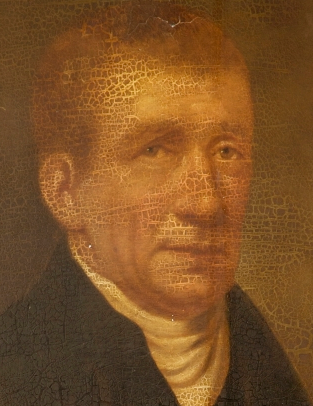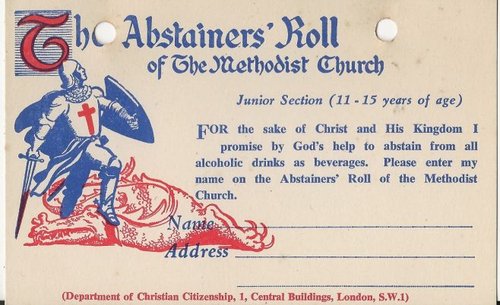Temperance
In Methodist usage the word has come to be associated almost exclusively with the use of alcohol. Total abstinence has never been imposed as a condition of membership, and in 1841 the WM Conference actually ruled against its chapels being used for teetotal meetings and against the use of unfermented communion wine. In 1868 the Methodist Temperance Magazine was launched by Charles Garrett and in 1874 the Conference adopted 'Resolutions respecting Temperance', which included proposed steps to consolidate 'the opposition to the evils of Intemperance'. As a result of this, a Wesleyan Methodist Temperance Committee was set up in 1875, charged with encouraging abstinence and warning about the dangers of alcohol abuse. The setting up of Bands of Hope was also sanctioned. It became the Temperance and Social Welfare Committee in 1918, incorporating what had been separate committees on 'the Lord's Day' and 'social purity'.
A resolution in the Conference of 1917 briefly gave Methodist support to the Prohibition movement, but this seems to have died a natural death. A leading Wesleyan Methodist figure in the campaign against drink was Henry Carter who was head of the Temperance and Social Welfare Department from 1932 to 1942.
With a widening social brief after Methodist Union, in 1950 the Department became the Christian Citizenship Department; then, in 1973, the Division of Social Responsibility.

The other branches of Methodism, notably the Primitive Methodists, were less hesitant about the need for temperance advocacy, especially in the wake of the 1830 Beer Act. So they played a significant part in the Temperance Movement which developed in the nineteenth century and also in such organizations as the Independent Order of Rechabites, the United Kingdom Alliance and the Band of Hope Union. Hugh Bourne became a strong teetotaler. Temperance societies received connexional support in Primitive Methodism as early as 1832 and in 1841 the Primitive Methodist Conference recommended the use of unfermented wine in the Communion Service. There were some tensions: a Louth Circuit Teetotal Primitive Methodist Preachers' Plan for 1839 survives, issued following the departure of the radical teetotal Primitive Methodist travelling preacher Stamp, John by his successor Adolphus Beckerlegge.
Methodist support for the temperance movement was particularly strong in Cornwall, Lancashire and Lincolnshire. Three of the 'Seven Men of Preston' were Primitive Methodists. The Methodist Temperance Magazine, first published by S.W. Partridge in 1868 and renamed the Temperance Pioneer from 1907, was taken over by the WM Temperance Department in 1912 and continued as The Pioneer: a journal of temperance and social progress until 1925.
The practice of total abstinence is no longer as widespread among Methodists as it was and few churches now maintain an 'abstainer's roll'. The once lively debate between 'prohibitionists' and 'moral suasionists' no longer excites much interest. But there is concern about the wider issue of drug addiction and a recognition that the abuse of alcohol is part of that larger problem. Alcoholism is seen as an illness and the Church is associated with centres for treatment and rehabilitation. The acknowledged dangers of 'drink driving' have added weight to Methodism's insistence on responsible attitudes and the legislative control of the drink trade.
The 1974 Conference accepted a Declaration on the Non-medical Use of Drugs, which charged each individual to 'consider his personal attitude to all drugs in relation to his Christian vocation'. SO 919, prohibiting the supply, sale or use of intoxicants on Methodist premises' and directing non-alcoholic wine to be used in the sacrament, remained unchanged. A Memorial from the Swindon Circuit suggesting that the use of alcohol be permitted in manses was debated over several years, with the result that in 1977 SO 919(1) was amended to read: 'The supply, sale or use of intoxicants on Methodist premises, except use on domestic occasions in private houses, is not permitted in any circumstances.'

After widespread consultation and debate, the Conference of 2000 voted to confirm the existing position, prohibiting the supply, sale or use of intoxicants on (non-residential) Methodist premises or elsewhere in the name of the Methodist Church, and stipulating that the wine used in the sacrament of the Lord's Supper must be non-alcoholic. In 2004 an exception to the rule about not supplying alcohol on Methodist premises was created with regard to events taking place on premises used, as a significant part of the Church's mission and activity, as a conference centre. In 2015 it was further resolved that the rule should not apply to Methodist premises not required for model trust purposes and therefore being leased on commercial terms, except that they are not being used as drinking establishments or nightclubs. In 2005 it was agreed that, subject to authorisation and certain conditions, alcohol may be supplied at public events off church premises but using the name of the Church.
Photo credit: Hugh Bourne portrait, Englesea Brook Chapel & Museum
Photo credit: Patrick Slattery. Abstainers' Roll of The Methodist Church - My Methodist History.
Authored by Kenneth G. Greet and Susan R. Howdle for DMBI: A Dictionary of Methodism in Britain and Ireland